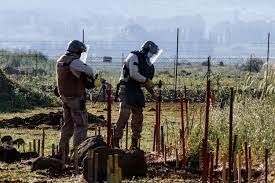22/07/2023 Libano, Nabatieh, Hasbaya, Wazzani (Al Wazzani-Al-Ouazzani-Arab Louaize-Aarab El Louaizeh)
“If you ever come across anything suspicious like this item, please do not pick it up, contact your local law and/or enforcement agency for assistance”.
By Francisco Serrano, a journalist and writer covering the Middle East and North Africa.
On a spring morning near the town of Aarab el-Louaizeh in southern Lebanon, 39-year-old Zeinab Hashem sported an unconventional outfit. In a heavy vest, helmet, and visor that chafed against her skin in the warm weather, Hashem slowly swung a metal detector to survey the few steps of dirt ground ahead of her before declaring them safe. Her protective mine-sweeping equipment was clunky—but potentially lifesaving in dealing with land mines and undetonated explosives left over from decades of domestic and regional conflict. From 1975 to 1990, Lebanon fought a civil war, during which Israel occupied large portions of southern Lebanon and left hundreds of thousands of anti-personnel and anti-tank mines on Lebanese territory along the two countries’ shared 75-mile border. In 2006, a monthlong war between the Lebanese militia Hezbollah and Israel led Israel to drop as many as 4 million cluster munitions on Lebanon, roughly 90 percent of them in the final three days of fighting. As they fall to the ground, cluster bombs release a multitude of smaller explosives over a broad area. An estimated 1 million of these did not explode. The deadly metal containers are the size of a can of soda and can lay dormant on the ground for years. More recently, spillover from the conflict in Syria led the Islamic State and Nusra Front militants to temporarily occupy parts of northeastern Lebanon and leave improvised explosive devices in the areas they controlled in Ras Baalbek and Arsal. Israeli soldiers retreated from southern Lebanon in 2000, and United Nations peacekeepers now oversee the small buffer zone—the width of a dirt road between Lebanon and Israel that acted as the demarcation for the Israeli troops’ withdrawal, known as the Blue Line. The patch of territory where Zeinab works is overlooked by an Israeli military outpost only a few hundred meters away. When demining work in Lebanon began in 2000, roughly 37,000 acres of the country’s territory were estimated to be contaminated by land mines and unexploded munitions. Demining work was initially done by the military. Humanitarian demining started a year later, when the Mines Advisory Group (MAG), a U.K. nongovernmental organization, began to operate in the country. Though more than 80 percent of contaminated land has been cleared, further work can’t move fast enough.
Photo-Source: foreignpolicy.com
Dear editors, Biography of a bomb is aimed at highlighting the danger caused by unexploded bombs. Moreover, the most important aspect is that we work completely non profit, what drives us is raising awerness about this topic. We make use of your pictures and articles, but we need them to put a context in how findings are done. We trust in your understanding. We will (and we always do) cite the source and the author. We thank you for your comprehension.





